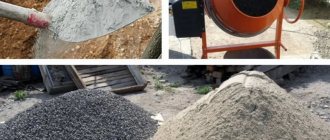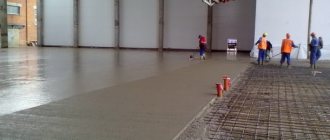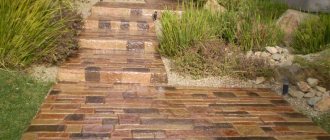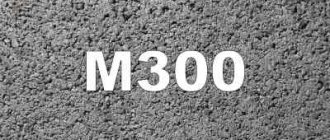Features of a concrete kitchen
In the 20s of the last century, the rhythm of life acquired dynamics, industry began to develop, and an avant-garde movement in art arose - constructivism. At this point, concrete began to be used in residential premises as a full-fledged finishing material. Over time, concrete surfaces have become established in styles such as minimalism, loft and hi-tech.
The material, which was previously used exclusively as a rough finish, has become one of the signs of a stylish interior. Concrete floors and walls finished with decorative plaster with a recognizable rough surface are not uncommon in modern living rooms and bedrooms.
With an emphasis on the top shelves Source idfactory.ru
A minimalist concrete kitchen fits well into the space of a loft, minimalism and other modern trends. Its main feature is a decorative coating on facades that reproduces the texture and shade of concrete. The kitchen is often equipped with a concrete countertop.
The basis of the facades is made of MDF or chipboard (budget option). One of the types of coating is melamine - a multi-layer synthetic material, some varieties of which are known as artificial veneer. Facades with melamine coating have the following advantages:
- Resistance to mechanical shocks . The surface is scratch-resistant; strength can be increased if several layers of melamine are used.
- Resistance to chemical compounds , including alcohols and solvents.
- Moisture resistance and easy care.
With a wooden countertop Source kuhnov.ru
There is another way to imitate a concrete surface - using microcement (another name is microconcrete). This is a type of decorative plaster, which contains cement and finely ground quartz sand; A polymer solution is used as a liquid component. The finished surface is coated with a protective varnish, which protects the facade from moisture and premature wear.
Microcement is easy to apply and holds firmly, prized for its endless color range and impact resistance. For care, you can use regular detergents.
With wooden bar counter Source kuechen-holland.de
Advantages and disadvantages
Modern design involves searching for the best combination of the appearance of the room with maximum practicality. Therefore, kitchens with concrete facades are gaining popularity.
The fashion for loft style elements in the interior dictates the need to search for materials that can embody the severity of forms, convenience, and durability of details that embody the post-industrial world. Concrete facades have a number of advantages over classic materials intended for finishing the dining space.
The main ones are the following properties:
- Strength and wear resistance. The concrete product has a long service life. Kitchen cabinets and countertops are not subject to wear and tear for a long time due to the low deformation rates and brittleness of the compounds included in the substance. Choice of shapes and textures. The high plasticity of the material makes it possible to implement non-standard design solutions. Using molds of various sizes, volumes and reliefs, you can cast non-standard kitchen details that will highlight the individuality of its owners. Environmental friendliness. The materials consist of natural components, which makes the products safe for humans. Price. The cost of concrete is much lower than solid wood or natural stone used for the production of kitchen furniture.
However, such facades have a number of disadvantages that complicate their use for finishing dining rooms and combined work areas for food preparation.
The main negative aspects include:
Limited choice of finished products. The fashion for concrete kitchens has appeared recently, so even in such a large city as Moscow, buying a set with a similar finish is problematic. Most often, the kit must be ordered, which increases its final cost. Low moisture resistance. Concrete deteriorates in high humidity conditions. There is a need for additional processing of products with special substances.
Limited color scheme and room design. Finishing a kitchen using concrete parts is only suitable for interiors designed in loft, industrialism or Chicago style. Dark shades of the material do not allow creating a bright palette of colors. Temperature. Concrete sets should not be installed in rooms with low temperatures. In this case, the cold material does not help maintain a comfortable microclimate.
Before making a decision in favor of concrete facades, you should think through the interior design as much as possible, create a design project, taking into account the advantages of the material and ways to reduce its disadvantages.
Currently reading: Do-it-yourself concrete countertop (concrete) imitating natural stone
Tabletop
The material for the countertop is interior concrete, which has a porous structure. It is not afraid of water, but it is quite difficult to get rid of impurities that get into the pores. In addition, the binder contains calcium, which quickly breaks down in an acidic environment. If the concrete panel is not protected, any acid (for example, in lemon juice) will leave a dull stain on the surface.
Therefore, the concrete countertop is covered with a protective polymer coating. It is applied in a thin, invisible layer and closes the pores on the surface, after which the countertop behaves impeccably. The polymer is not dangerous to table vinegar (9%) and other acids; You don’t have to be afraid of ordinary coloring liquids, like wine or coffee.
The varnish coating can be glossy or matte, and lasts for many years without updating (subject to careful use).
Loft style kitchen project Source altastore.ru
See also: Projects of houses with a kitchen
Manufacturers offer ways to make a concrete countertop more decorative:
- There are pigments that can give concrete color (including white). The palette is not very diverse, but color is not the main advantage of the material.
- During production, a large aggregate is added to the solution: shell rock, broken glass or natural stone. The top layer is then sanded off to reveal the resulting texture.
- An option popular in Western countries: the tabletop is inlaid with solid wood of valuable species.
Loft interior Source pinimg.com
How to make a kitchen out of concrete
The first step is to create a plan for the future kitchen - determine the size of the cabinets, the overall length, the width of the countertop, etc. They make a decision regarding the design of the set, which will depend on the main design idea. They specify the location of the equipment and its dimensions, also marking them on paper.
Formwork
The formwork for pouring is prepared from plywood, laminate, chipboard. For easy removal, the internal surfaces are covered with plastic film.
Formwork for concrete table top
Casting can be done in a direct or reverse manner. In the first case, the front side of the part will be its top, in the second - the bottom. The reverse method makes it possible to produce smoother elements and simplify the finishing of concrete.
Main stage
After installing the copper wiring, production of individual elements of the kitchen set begins. Partitions are often formed from ready-made tongue-and-groove or foam concrete blocks, which are easily sawed, drilled and attached to the walls and floor.
Doors for facades are ordered strictly in size according to the plan. If desired, they can be made with recesses for the tiles. The doors can also be aged using a metal brush or stain, impregnation, or special putty for concrete.
Kitchen countertop
To fill the countertop, use ordinary cement mortar. To make it more decorative, you can add pigment, including white.
To give an interesting texture, shell rock, natural stone, broken glass are added to the solution, and then the top layer is slightly sanded. To obtain a smooth surface, apply a self-leveling floor mixture as the final layer. Bonded fiberglass reinforcement or mesh must be placed at the bottom of the formwork.
Finishing
All cracks and joints in a monolithic kitchen are coated with sealant. Cut a hole for the sink, if the latter is not concrete according to the design project.
The tabletop and other elements are carefully sanded, primed, fittings, edge moldings and other components are glued. If necessary, install the tiles and grout the seams.
Since concrete is a porous material, and grease and dirt will constantly penetrate into its pores, it is necessary to take a number of protective measures. All concrete elements are coated with a polymer water-repellent coating, which will make the surface resistant even to acids, dyes and alcohols. This coating can be glossy or matte and will need to be renewed periodically.
The technology for making kitchens from concrete is quite complex, and the work takes a lot of time. But the result of the work will be an original design, which will immediately become the center of attention in the house and will delight the owners for many years.
Combination of facades with different finishes
Although concrete is a man-made material, its effect on perception is reminiscent of natural textures, and therefore can be easily combined with them. At the psychological level, the concrete surface is perceived as heavy (especially if the dark option is chosen). Therefore, this texture is more often used for lower facades, and the finishing of the upper part is made lighter or from a different material. The following materials are used for the upper facades:
- Wood . If you choose concrete and wood for your kitchen, the interior will always remain trendy. Wooden fragments maintain an atmosphere of warmth and comfort in the kitchen, balancing the strict gray color. The interior turns out lighter and visually lighter.
- Plastic . It is valued for its color and texture diversity, as well as for its budget. The combination of plastic and concrete facades is successfully practiced, especially when it is necessary to create an unusual color accent, and wood is powerless.
Concrete and plastic Source ctfassets.net
Variety of designs
Kitchen sets with concrete facades are not as varied in appearance as furniture made from other materials. Homeowners evaluating different kitchen options often consider the color of concrete as a drawback, because they are afraid that the interior will look heavy.
Manufacturers, trying to expand their range, offer combined kitchen options with concrete and wooden facades:
- Concrete and light wood . For this combination, light types of wood are selected: oak, ash, maple. The contrasting combination of concrete and wood textures in the interior looks refreshing. Light gray and gray-beige facades look harmonious with wood in a natural light tint.
Concrete and light wood Source arthur-bonnet.com
- Concrete and dark wood . The combination turns out to be more brutal, and is not suitable for all interiors. As a rule, the tinting of wood matches the shade of concrete in saturation, which looks impressive. The combination is often chosen for the design of loft interiors.
- Combinations with dark interior concrete . The dark, uniform color of the concrete surface enhances the impression of the furniture. This option is chosen if the interior involves bright color accents (typical for loft, high-tech).
Concrete and dark wood Source wixstatic.com
Development of drawings
First of all, you need to decide what the future table will look like and what its dimensions will be. When making a kitchen countertop, the edges of the surface must be exactly adjacent to the walls. Since the corner of the room is usually used to install the kitchen table where the sink is located, you should make sure that it has the correct shape, that is, the walls meet at an angle of 90°. If the angle has different dimensions, then this must be taken into account at the drawing stage.
Creating an accurate drawing of the countertop is the most important stage of the work, since the quality of the finished product depends on the thoroughness of its development. In the process of developing a drawing, it is necessary to provide for the creation of a tabletop from several parts. The weight of the finished product in its entirety is large, so dividing it into parts during manufacturing will make it easier to move and process them, and will also protect against the formation of cracks.
We recommend: Homemade roof gutters, do it yourself: how to make a drainage system from sewer pipes, plastic bottles, wood and profiles
When making a table frame with your own hands, you should consider strengthening its central part with transverse boards, as well as joining individual parts of the tabletop on them. Hardwood boards are used for the frame. If desired, you can use ready-made cabinets with drawers. It all depends on the imagination of the home master.
Marble
This natural stone is timeless and looks equally good both in palace halls and in home spaces. The solemnity of a classic marble pattern often seems too pompous for a kitchen space, however, by varying the intensity of the color of the veins, the general background and the laconicism of the façade of the set, you can reduce the degree of pomp and make the cladding more comfortable and calm.
Marble decoration is so self-sufficient that in general it does not need companions and looks great when performed alone. Of particular interest are both traditional white stone with gray veins and contrasting dark varieties, as well as sandy shades of rocks.
Dark concrete
Using dark colors, it is necessary to perfectly combine them with light facades, countertops, and shiny metal surfaces.
The ceiling in such a space is best made snow-white. A kitchen with dark concrete in combination with dark wood looks very unusual - this look becomes as brutal as possible.
Attention! To prevent the room from looking gloomy and very black, it is better to paint the walls, flooring and ceiling in an intermediate color, and use dark material in fragments.
From dark material it is possible to create accent walls, flooring, countertops, and islands. The overall picture can be complemented by piercing or shiny parts, such as a faucet or furniture handles. Thanks to dark coloring, it is possible to add harmony to interior themes or achieve a clear division of the room.
Stone and wood
The same universal marble looks great next to a cozy wood relief. Both types of finishes belong to the classic type of cladding and look great in any interior. Since capricious wood does not withstand the harsh operating conditions of the kitchen, it is replaced by high-quality porcelain stoneware imitations.
The most relevant combinations are obtained by combining wood with:
- marble;
- granite;
- onyx;
- travertine.
The arrangement of elements depends solely on the taste of the owners. With equal success, you can use both wood and stone to finish a kitchen apron (floor).
Tree
The tree looks unusually contrasting against the background of concrete products. Wooden surfaces look warm and represent the beauty of nature, while concrete is an industrial and therefore cold material.
The basic rule when combining these natural materials is to use them separately. If the kitchen set is made of concrete, then it is better to use wood for finishing the floor or walls.
And also to make the design more balanced, it is necessary to focus on one of the materials. Thus, when using predominantly concrete products, the inclusion of wood should be minimized . Otherwise, the design will look too complicated and clumsy.
Patchwork and clay
The patchwork pattern looks great in both modern and vintage kitchens. A bright, stylish print, most often used in the apron area, attracts increased attention and needs special allies not only in the design of the facade of the set, but in the floor cladding.
By varying the brightness of the palette and the activity of the pattern, patchwork can be used in both wall and floor decoration. However, for small rooms it is better to limit the design to only one plane. Patchwork mosaic looks good with plain elements and in most cases goes well with clay tiles. The warm tones of this natural material have a modest and homely feel, in keeping with the overall vintage aesthetic.
White concrete
Kitchen in white colors
A color palette of gray and snow-white accents can be applied to the walls, floor, and kitchen units.
Designers will recommend radically opposing structures and substances for such a background. For example, furniture made of wood, bright glossy facades, countertops made of natural flint, and photo wallpaper are well suited.
If there is enough space, it is possible to install a sofa in the kitchen. It will fill the space with comfort.
For reference! In a small room and kitchen with white concrete, chairs or stools decorated with soft cushions will help create a homely atmosphere.
Hog and chess layout
Over the past few years, compact boar tiles have occupied a leading position in modern design. Imitation of brickwork can be found not only in the kitchen or bathroom, but also in the hallway, as well as living rooms.
Most often, white tiles are used for the interior. With it you can create a Scandinavian or modern style, an atmosphere in the spirit of loft, Provence and retro. A traditional black and white chess layout is suitable for any of the above options.
Plastic
Plastic panels are inexpensive, easy to install and offer a large selection of colors and textures. Therefore, the combination of plastic and concrete is acceptable and actively practiced. A wide variety of colors of plastic elements allow you to make interesting accents and enhance the contrast of the concrete finish.
Hexagons and concrete
Fans of modern style can try replacing classic rectangular tiles with popular hexagonal collections. The hexagonal elements form an attractive honeycomb pattern, which looks so bright and stylish that it does not require additional decor.
An apron decorated with hexagons of fashionable dusty shades looks good in contrast with laconic concrete floor tiles, which reduces unnecessary visual load from the interior.
We recommend: Sliding interior doors: types, features, installation
Beige concrete
A gray-beige shade will help create a conservative design in nude tones. In a room located on the north side, sandy, straw or white colors can add more warmth to the environment.
A light concrete kitchen will look grateful with a luxurious black, coffee, embossed reddish or languid lilac apron. For beige-colored flooring, it is appropriate to use natural wood, parquet, laminate or even planed boards.
Terrazzo
The renewed interest in traditional terrazzo finishes in recent years has allowed the introduction of an interesting new type of design into the kitchen space. Ceramic imitation of stone chips filled with concrete looks modern and stylish, and the practicality of the design makes its use especially comfortable.
Terrazzo is equally suitable for both floor and wall cladding. To make the interior more varied, you can “play” a little with the format and use not only the classic square or rectangular format, but also hexagonal elements.
Brick
The combination of brick and concrete is traditionally considered the most beautiful and organic. These materials are similar in their properties, so they are easy to combine. This tandem fits especially harmoniously into a loft-style interior. And if the design is dominated by the use of brick, then you can create a medieval interior.
Light concrete
This material itself is quite cold, so it is better not to choose it for cold rooms. A light concrete kitchen is excellent because water stains are not as visible on it as on the dark version. Therefore, such a solution will become more practical.
It mixes perfectly with azure, greenish, lilac, and red. It will help you create a calm, yet modern design. Lightweight and delicate light gray tone blends well with the glossy facades of the furniture.
Island
The island always stands separately from the kitchen (that’s why it’s an island) and is visually perceived as a separate product. It makes no sense to use a combination of decors on the island. It looks much more interesting in one decor with an accent (not necessarily) in the form of a tabletop.
Worthy companions of concrete
In order to soften the severity and coldness of concrete, it is worth using it in combination with other finishing materials. Wooden elements of kitchen furniture are particularly suitable for this. Concrete harmonizes well with the shine of furniture facades, preferably in light, white or neutral tones. In any case, the neutral color scheme of concrete remains the background for any shades.
Bright, rich colors such as red, lime, amaranth and turquoise look very good on this material. A concrete kitchen should have plenty of plant accents. The lush greenery of the flowers allows you to create an atmosphere pleasing to the eye. The overall picture can be complemented by metal or chrome elements, such as a faucet or furniture handles.
Island
If the kitchen area and the desire of the owners allows an additional island with a concrete base to be installed, it should certainly be used as an important aesthetic detail of the interior. Despite the fact that the island is perceived as a separate object, its decor is based on the appearance of the kitchen unit.
For the interior to look harmonious, the color of the island must match one of the colors of the facade. If the facades are decorated in the same color, the concrete surface of the island can be contrasting.
An island with an accent in the form of a countertop made of other materials looks advantageous. A wooden surface that can be used as a bar counter will look especially beautiful. For a large room, you can choose an island of an original shape, for example, with a two-tier tabletop.
Monochrome island Source wixstatic.com
Design options for kitchen aprons
Laying porcelain tiles is a very labor-intensive process that requires a lot of experience, concentration and accuracy. When laying, the specific layout and method of cutting porcelain tiles is very important. For example, from tiles of this type you can lay out a geometric pattern, combining imitations of different types of marble. In our article we will show both simple and more complex options for laying porcelain tiles for backsplashes and floors.
Luxurious kitchen in a yacht variation of the art deco style in caramel tones
A yacht-style kitchen can have porcelain tile floors, splashbacks, walls, countertops, as well as window sills, baseboards, and facades (especially near the island). In such an interior, you can combine both porcelain tiles from different collections and complementary models from the same collection, which have already been matched to each other by the brand designer. Please note that in the photo above, brown marble-like porcelain tiles are repeated in the finishing of the apron, countertop and floor.
Black Italian marble backsplash with white veins
The interior design of the neoclassical kitchen in the design project above is based on a combination of several dark shades. Black marbled porcelain tiles look great here with amazing charcoal fittings and dark brown flooring.
Bright kitchen with a white marbled apron in a pro-French interior
The most popular and current backsplash design is white marbled porcelain tiles with gray veins. It can be found in styles such as neoclassical, classic, modern, Scandinavian, minimalism. It is organically combined with porcelain stoneware imitating marble of other types, and with porcelain stoneware imitating parquet.
Combined backsplash finish with white Italian marble
The apron, countertop, side facades, floor, window sills and other details can be decorated in the same color and pattern.
Luxurious English country style kitchen with white and gray marble splashback
This option clearly demonstrates the elegance of such a material as porcelain stoneware imitating white Italian marble. In the photo above you see a kitchen set in English country style (from the neoclassical line). This two-color set is effectively emphasized by the noble breed of this stone.
How to combine with styles
Although a kitchen set with concrete facades fits into a limited number of styles, choosing suitable finishing materials is quite difficult, since it is necessary to take into account not only color, but also texture.
It is also important not to get carried away with excessive decorativeness. All suitable styles (minimalism, loft, hi-tech) are quite strict in terms of decor. A concrete kitchen in such an interior is a conceptual thing, and the desire to “make it more beautiful” will obscure the zest of the interior. To maintain stylistic purity, use the following techniques:
- Finishing materials are selected in the appropriate color palette.
- The walls are made monochromatic. The material chosen is paint, decorative plaster or wallpaper for painting.
- The wallpaper should not have a pattern or textured decor, this will reduce the cost of the design.
Minimalism Source noltesaintgermain.fr
Fashionable colors of floor and wall tiles in kitchen design
Floor tiles are more than just a floor color. This is also a drawing, as well as future practicality in cleaning. In this case, porcelain tiles are an excellent option for any housewife, because cleaning them is not difficult at all, and the small number of joints due to the large format makes it even easier. He will not require special conditions to restore order in the room.
But wall tiles do not have much influence on how the room will be cleaned. True, there are some types of finishes that may not be practical enough. Our interior designers always take into account all the details, including how the apron will look in the constant presence of splashes of water, grease from cooking and other contaminants. Next, we will look at some of the most practical color options for porcelain tiles in the kitchen.
White palette: modern and light
Porcelain tiles for the kitchen floor and splashback should be selected taking into account the style, color scheme, and general mood of the interior. The most popular now is porcelain tiles imitating white, grey, beige, black and brown marble in traditional shades, as well as porcelain tiles imitating wood/parquet, concrete and stone, for example, slate or pebbles. The design of a white kitchen is rarely complete without light finishing materials.
Brown palette: cozy and traditional
In the photo of the interior above you can see brown China Dark marble in a dark chocolate shade (or you can buy porcelain tiles to match this type of marble) and kitchen facades made of natural eucalyptus.
Gray palette: sophisticated and elegant
The photo above shows a quartz-colored kitchen set in a glossy finish. And in the finishing of the combined floor, you can notice the shade of wet asphalt in the marbled design.
Beige palette: feminine and artful
In the photo above you can see the kitchen floor design in a pale melon shade. The beige palette looks great in this modern interior. It is worth adding a bright accent to the interior in such colors, for example, as in this case, a green kitchen apron.
Green palette: original and rich
Green color in interior design is currently a significant uptrend. As a rule, we are talking about deep dark shades (emerald, malachite, blue-green, jade).
Briefly about the main thing
Choosing a kitchen for concrete is justified if the material is in harmony with the style of the room. Concrete facades look beautiful in high-tech, loft and minimalist interiors. For the manufacture of kitchen units, microcement or melamine coating is used. If interior concrete is chosen as the countertop material, it is protected with a layer of varnish, matte or glossy.
The design of a kitchen with concrete facades is quite diverse. Combinations with wood and plastic are used, diluting the monotony of the material. In order to harmoniously fit furniture into the interior, it is important to choose finishing materials that match the style in color and texture.
Ratings 0











